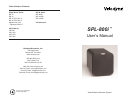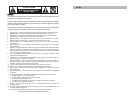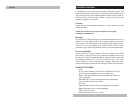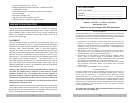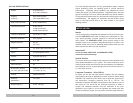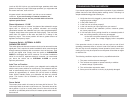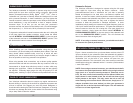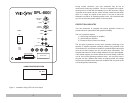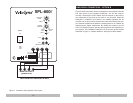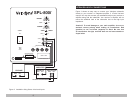
P
P
P
P
Subwoofer Outputs
The Velodyne subwoofer is designed to operate using the full range
audio signal for input when using the built-in crossover. Some
processors/receivers have a “subwoofer out” jack that is internally
filtered and designed to be used with a conventional amplifier and
speaker. In some rare cases, combining both an external crossover and
the one internal to the subwoofer may result in low output and increased
noise. In these installations you may need to bypass the internal
crossover in either the processor or Velodyne subwoofer. In some
installations, simply setting one crossover to a higher frequency (such as
120 Hz) will restore maximum performance. To bypass the subwoofer’s
internal crossover when the unit is being fed a low pass signal from
another crossover, simply locate the switch marked INTERNAL X-
OVER/SUBWOOFER DIRECT on the rear panel of the subwoofer and
set to the SUBWOOFER DIRECT position. This will eliminate the
internal crossover from the signal path.
NOTE: If not using an external crossover, you should use the built-
in crossover for optimal performance.
LINE-LEVEL CONNECTION – OPTION A
Figure 1 shows connection from your home theater receiver to the LFE
input on the back of your subwoofer. When the subwoofer is installed in
this fashion, all of the low frequency information from your “LFE Out” or
“Subwoofer Out” on the back of your receiver will pass into your
Velodyne subwoofer. This connection is the most common connection
method when using your subwoofer with a 5.1 receiver. (Cable needed:
1 mono RCA cable.)
NOTE: If not using an external crossover, you should use the built-
in crossover for optimal performance. When using a single channel
input (such as a surround sound processor’s subwoofer out or
LFE), the auto on/off circuit sensitivity will be affected. When one
input channel is used instead of two, the unit will see lower signal
levels present at the inputs. This may cause the unit to turn off
when listening at low volume levels. If this occurs, simply use a “Y”
adapter (available from most dealers) to allow your processor’s
single sub line to be fed into both L&R inputs. This will make the
unit turn on at lower signal levels.
5
SUBWOOFER OUTPUTS
The Velodyne subwoofer is designed to operate using the full range
audio signal for input when using the built-in crossover. Many home
theater processors/receivers (Dolby Digital
®
, DTS
®
, THX
™
) have a
“subwoofer out” jack that is internally filtered and designed to be used
with a powered subwoofer. In these installations, you may bypass the
internal crossover in either the processor or the Velodyne subwoofer. In
some installations, it may be beneficial to have a steeper ultimate
crossover slope. To do this, you can use both your processor’s
crossover and the one internal to the Velodyne sub. You should stagger
the frequencies, (i.e., 120 Hz sub, 80 Hz processor) for best results.
To bypass the subwoofer’s internal crossover when the unit is being fed
a low pass signal from another crossover, simply locate the switch
marked INTERNAL X-OVER/SUBWOOFER DIRECT on the rear panel
of the subwoofer and set to the SUBWOOFER DIRECT position. This
will eliminate the internal crossover from the signal path.
INTERCONNECT CABLES
When installing your new Velodyne subwoofer using the line level
connections, you should always use shielded phono cables. There are
many decent cables available today, most any of which will work
perfectly well. We do recommend that you keep the length of cable as
short as possible to avoid any potential noise problems.
When using speaker level connections, use a decent quality speaker
cable that mates well with the connectors. Be very careful to avoid any
loose strands or frayed wires which may result in a short, which may
damage your equipment. Cables of extremely large size are typically
not required. Extremely large gauge wire may not properly fit in the
binding posts, resulting in a poor connection and possible short circuits.
CARE OF YOUR SUBWOOFER
Your Velodyne subwoofer does not require any regular maintenance.
Normal dusting or cleaning of the surface for appearance purposes are
all that is required. W
e suggest you avoid any harsh detergent
s or
chemicals when cleaning the cabinet.
Abrasives, detergent
s, or cleaning
solutions may damage the finish on the cabinet. W
e recommend using
only a damp cloth to clean the cabinet.
12



